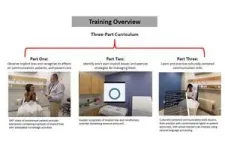(Press-News.org) CHAMPAIGN, Ill. — During a checkup with her obstetrician, Marilyn Hayes tells him about overwhelming exhaustion and possible symptoms of postpartum depression, such as feeling unsafe. Hayes, a Black woman, grows increasingly frustrated as her white, male physician, Dr. Richard Flynn, dismisses her symptoms and ignores her wishes when she refuses medication. Hayes becomes visibly uncomfortable when Flynn touches her without permission and makes comments steeped in Black stereotypes, such as assuming that she’s unmarried and the baby’s father is uninvolved with her and their infant.
While Hayes and Flynn are fictional characters depicted in a virtual reality video, Hayes’ experiences are similar to those of many Black women and women of color when they interact with clinicians and their staff members, studies have found. Hayes’ checkup with Flynn is the first in a series of three virtual reality training modules being developed to heighten physicians’ awareness of implicit bias in patient care and cultural competency skills.
“Ultimately, this virtual reality training system could become a viable tool for practicing communication with diverse patients across different types of health care professions,” said Charee Thompson, a professor of communication at the University of Illinois Urbana-Champaign who studies physician-patient communication and is one of the team members developing the virtual reality training series.
“There’s no reason why nurses couldn’t also use this across different health care contexts — not just for Black maternal health, but chronic pain, diabetes or some of these other health issues in which we know that there are disparities based on markers of difference such as race or class,” she said.
Thompson is the first author of a study about the project, published in Health Communication. She and her co-authors Mardia Bishop, a professor in the same department at the U. of I.; and obstetricians and gynecologists Dr. Tiffani Dillard of Carle Foundation Hospital in Urbana, Illinois; and Dr. Joseph Maurice of Creighton University School of Medicine in Omaha, Nebraska, are leading the team that is developing the modules.
The first module, which focuses on Black maternal health care, was tested in a pilot study with 30 medical students and resident physicians. Prior to and after viewing Hayes’ and Flynn’s interaction, the study participants completed a survey that taps into physicians’ beliefs about the value of eliciting patients’ opinions about the cause of their illnesses and how it affects their lives, and whether physicians can provide excellent health care without asking patients for their perspectives.
“We know that disparities in Black maternal health affect or are connected to disparities for Black infants, including preterm birth and low birth weights,” Thompson said. “And so, for me, this is one of the most urgent needs when it comes to the health of women and children.”
In Flynn’s interactions with Hayes, students saw how bias and Black stereotypes affect his communication, such as when he leaps to the conclusion that Hayes feels unsafe because her husband is violent, rather than recognizing it is a symptom of depression, Bishop said.
“The video depicts the doctor going through the entire postpartum checkup, asking questions about breastfeeding, the incision and healing. Throughout the video, the viewer can see where the provider is behaving or communicating with implicit bias and the effect this has on the patient,” Bishop said. “Sometimes it can be difficult to recognize bias or realize that what one is saying or doing demonstrates bias. This video shows the many ways that implicit bias can enter a discussion with a patient.”
According to the post-training survey, participants’ awareness of implicit bias, their attitudes toward culturally competent communication and their confidence in their individual communication efficacy significantly increased after the training, Thompson said.
Two open-ended questions on the survey asked participants how they would provide more empathic, individualized care for Black postpartum women. The participants responded that they were committed to building rapport with patients by prioritizing their concerns and feelings, allowing patients greater opportunities to express themselves and engaging in shared decision-making. Participants said they would listen more attentively, be more aware of their own body language, display compassion and empathy, and pay attention to patients’ verbal and nonverbal cues.
The second virtual reality training module — which is still under development, along with a third module — promotes self-reflection by helping medical students identify their own biases and learn how to mitigate them, Thompson said. In the third module, students will practice their intercultural communication skills through interactions with a virtual patient.
While the cost of the first module was $40,000, Maurice said that for universities and medical schools, virtual reality training is a cost-effective option because it eliminates the need to recruit people for role playing with medical students. “It’s a lot cheaper to produce one video and show it 100 times, as opposed to hiring 100 people to role play with the students,” he said.
Creighton University awarded Maurice a $100,000 grant to implement the training at its campus in Phoenix. The grant will expand the sample population of medical students for the research to about 300 people, he said.
The Carle Illinois College of Medicine Health Maker Lab also provided funding for the project, as did the Jump ARCHES endowment through the U. of I.’s Health Care Engineering Systems Center.
Thenkurussi Kesavadas, then-founder-director of the Health Care Engineering Systems Center at the U. of I., co-wrote the paper. He is currently the vice president for research and economic development at the State University of New York at Albany.
Other co-authors included U. of I. alumni Manuel D. Pulido, a professor of communication studies at California State University, Long Beach; Corey Zeinstra, a software engineer in immersive technologies at Boeing; and M.J. Salas, a graduate student at Rutgers University.
U. of I. graduate students Déjà D. Rollins, Emily A. Mendelson, Jia Yan, Emily R. Gerlikovski and Sarah V. Benevento also co-wrote the study.
END
Virtual reality training for physicians aims to heal disparities in Black maternal health care
2024-07-22
ELSE PRESS RELEASES FROM THIS DATE:
Science, Social Studies classes can help young English-learning students learn to read and write in English
2024-07-22
A new study finds that science and social studies classes may also help young students learn English, even when those classes include difficult and technical vocabulary.
The study, which observed first- and second-grade students in 30 elementary schools in North Carolina, encouraged teachers to keep their English-learning students in class during science and social studies lessons. Science and social studies textbooks in those grades are often relatively technical and difficult for students, so traditional teaching methods in North Carolina encourage teachers to remove English-learning students from those content classes ...
Wijesekera receives funding for FHWA driving simulator support research: Hands-on support for CDA/CARMA - ARCHER Integration Phase I
2024-07-22
Duminda Wijesekera, Professor, Cybersecurity Engineering; Professor, Computer Science, received funding for the project: “FHWA Driving Simulator Support Research: Hands-on support for CDA/CARMA - ARCHER Integration Phase I.”
He will evaluate and test the Nvidia Drive Sim to understand functionality, behaviors, limitations, and interfaces that would be required in full integration.
Nvidia Drive Sim is a simulation platform for autonomous vehicles.
He will also work to discern the ...
Study: Retail viability in Fairfax City mixed use development
2024-07-22
Center for Retail Transformation (CRT) and Center for Real Estate Entrepreneurship (CREE) jointly received funding to study retail viability led by Mehmet Altug, Associate Professor, Information Systems and Operations Management and Director of CRT, Costello College of Business.
Led by Mehmet Altug, the two centers CRT and CREE at Costello College of Business have teamed up to determine market-specific retail opportunities within Fairfax City, specifically within five Small Area Plans. The project will specifically consider ...
Converting captured carbon to fuel: Study assesses what’s practical and what’s not
2024-07-22
The struggle to cut emissions is real.
Last year, the world emitted more than 37 billion metric tons of carbon dioxide, setting a new record high. As a result, sucking CO2 out of the atmosphere has become an increasingly popular idea. Governments worldwide are banking on this technology, called direct air capture, to help them achieve climate goals and avoid the worst consequences of climate change.
But despite more than a dozen direct air capture facilities being up and running around the globe already, the technology ...
University of Houston flexes scientific muscle with breakthrough in skeletal muscle regeneration
2024-07-22
Newly published research from the University of Houston College of Pharmacy identifies key mechanisms of skeletal muscle regeneration and growth of muscles following resistance exercise. It’s a finding that opens the door to the development of targeted therapies for various muscle disorders, like Muscular Dystrophy, which affect millions of people worldwide.
When it comes to muscles and muscle disorders, the importance of a discovery like this cannot be overstated.
The muscle of muscles
The ...
Argonne-led research working toward reducing electronic waste with biodegradable luminescent polymers
2024-07-22
From your car’s navigation display to the screen you are reading this on, luminescent polymers — a class of flexible materials that contain light-emitting molecules — are used in a variety of today’s electronics. Luminescent polymers stand out for their light-emitting capability, coupled with their remarkable flexibility and stretchability, showcasing vast potential across diverse fields of application.
However, once these electronics reach their end use, they are discarded, piling up in landfills or buried underground. Recycling this electronic waste is complex, requiring expensive ...
B cell biohack: USC engineers immune cells to churn out custom antibodies
2024-07-22
USC scientists have discovered a way to turn the body’s B cells into tiny surveillance machines and antibody factories that can pump out specially designed antibodies to destroy cancer cells or HIV, two of medicine’s most formidable foes.
The research, published today in Nature Biomedical Engineering, describes a technique for editing the genes of immune cells called B cells, turbocharging them to fight even the sneakiest invaders. The work is an important advance in harnessing the power of antibodies to treat conditions ranging from Alzheimer’s ...
Understanding how a red seaweed reduces methane emissions from cows
2024-07-22
Methane is the second-largest contributor to climate warming after carbon dioxide, and so scientists have put a lot of attention toward addressing one of the top sources: methane emissions from livestock. In other words, cow burps are bad for the planet.
Farmers add various seaweeds to cow diets as a source of protein, unsaturated fats, and other health-promoting ingredients that provide immediate energy, says Dipti Pitta of the University of Pennsylvania School of Veterinary Medicine, and a 2016 study in Australia found that feeding sheep a species ...
Genome study informs restoration of American chestnut tree
2024-07-22
Native trees adapt to the climate and environmental conditions of their area to survive. Researchers in the College of Natural Resources and Environment in collaboration with the American Chestnut Foundation confirmed this by examining the genome of American chestnut trees sampled throughout the Appalachian Mountain range and grouping the samples according to their specific environmental region.
The research, recently published in the Proceedings of the National Academy of Sciences journal, has the potential to help the ...
Improved efficacy of pembrolizumab when combined with sEphB4-HSA in HPV-negative EphrinB2-positive HNSCC
2024-07-22
“Future development for sEphB4-HSA in HNSCC is likely to focus on patients with HPV-negative disease where there is greatest need to improve on the outcomes with pembrolizumab monotherapy.”
BUFFALO, NY- July 22, 2024 – A new research paper was published in Oncotarget's Volume 15 on July 10, 2024, entitled, “Improved efficacy of pembrolizumab combined with soluble EphB4-albumin in HPV-negative EphrinB2 positive head neck squamous cell carcinoma.”
Patients with relapsed or metastatic head and neck squamous cell carcinoma (HNSCC) after primary local ...






